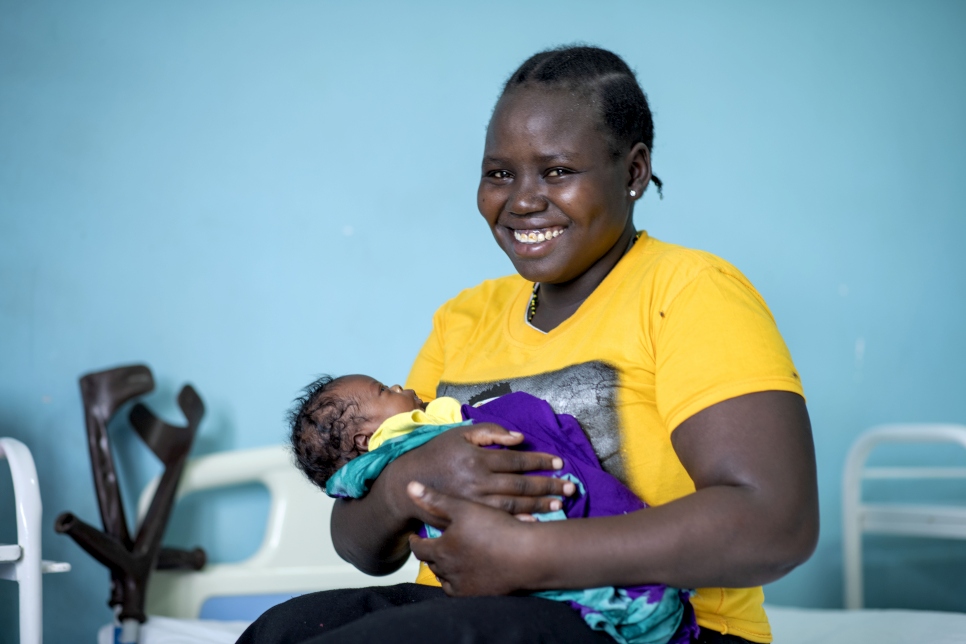Access to Healthcare
UNHCR’s public health strategy aims to foster the conditions, partnerships, collaboration and approaches that enable refugees to access healthcare and essential health services. Advocating for the inclusion of refugees into national health systems at affordable costs and sufficient quality is a priority. This strategy is in line with the Global Compact on Refugees and the 2030 Agenda for Sustainable Development.
How does UNHCR help refugees get healthcare?
In all situations, UNHCR advocates for refugee inclusion in national health systems and plans. When and as appropriate, UNHCR then provides guidance, infrastructure and capacity building, and funds laboratory diagnostics, medicines, medical equipment and supplies.
Through UNHCR’s advocacy, funding and support, refugees benefit from increased access to healthcare in the areas outlined below:
Primary Healthcare and Referrals for Secondary Healthcare
Primary healthcare practitioners provide support in the areas of sexual and reproductive health, nutrition, child health including immunizations, mental health and the treatment of communicable and noncommunicable diseases. Primary healthcare practitioners also make referrals to secondary healthcare for a higher level of clinical care.
UNHCR improves primary healthcare for refugees by advocating for refugee inclusion into national health systems, strengthening health infrastructure (e.g. constructing or renovating facilities, providing medicines, medical equipment and laboratory diagnostics), funding and training health workers.
Community Health
Whether in camps or urban settings, the overall health of host and refugee communities impacts each individual. Community health initiatives mostly take place outside of health facilities and focus on how community members can take action together to maintain or improve their health and prevent disease.
UNHCR trains community health workers to meet with refugees to diagnose, treat and make referrals for common illnesses (e.g., diarrhoea and malaria) and follow up with pregnant women, newborns and people living with chronic diseases (e.g., diabetes and hypertension). Fluent in refugee languages and cultures, community health workers teach refugees about health, hygiene and preventative health measures such as immunization from the same perspective more easily relatable.
Noncommunicable Diseases (NCDs) Prevention and Treatment
Noncommunicable diseases, such as heart disease, cancers, diabetes, chronic respiratory disease and mental health conditions, are the greatest source of preventable illness, disability, and mortality worldwide. Displacement can disrupt refugees’ treatment for these diseases or delay diagnosis, putting them at even greater risk.
In 2014, UNHCR began improving access to noncommunicable diseases care by ensuring that it is effectively integrated into primary healthcare. Through a capacity-building project, procurement of evidenced-based and cost-effective essential medicines and data collection and monitoring via the iRHIS (Integrated Refugee Health Information System), access to healthcare for noncommunicable diseases is now more available to refugees. UNHCR trains health staff on noncommunicable diseases care including screening, diagnosing and managing patients using clinical protocols (aligned with host country protocols). Capacity building includes training of staff to provide advice on smoking cessation, monitoring of disease control and awareness of complications.
Communicable Diseases Prevention and Treatment
Conflict and displacement that lead to refugee situations are a recognized public health risk. They increase the population’s vulnerability to communicable diseases because of weakened health systems, overcrowding, poor water and sanitation conditions, interrupted immunization activities and delayed diagnoses. The main cause of death in many conflict and displacement situations is not violence, but the spread of communicable diseases such as malaria, measles and diarrhea.
UNHCR approaches the control of communicable disease from multiple sectors by increasing the provision of or access to vaccinations (especially against measles, polio and tetanus) and to water and sanitation facilities. During all stages of refugee situations, UNHCR focuses on measures for HIV prevention and treatment. In addition, using the iRHIS, UNHCR undertakes surveillance for conditions that have the potential to lead to communicable disease outbreaks.
Immunization
When refugees flee their homes, healthcare gets put on hold, including immunizations. As a result, refugees, especially children, are at increased risk of contracting vaccine-preventable diseases including measles, polio, viral hepatitis, diphtheria and whooping cough. Refugee children are also at very high risk to be “zero-dose” (no immunization) or under-immunized. Adult refugees may face more severe forms of childhood diseases if they were not immunized as children.
UNHCR promotes that all new refugee arrivals under 15 years old immediately receive measles, polio and tetanus toxoid vaccines. While vaccines are most commonly obtained and administered through ministries of health or UNICEF, UNHCR often funds vaccination activities to reach as many refugees as possible. Depending on the situation, UNHCR may also procure vaccines and provide logistical support for their importation, transportation (including cold chain management) and storage. Through a 2020 partnership with GAVI, the Vaccine Alliance, UNHCR is identifying and addressing the needs of zero-dose refugee children. The partnership is working closely with communities and local partners to identify and overcome key barriers to immunization in communities, including gender divides and the gap in demand and access.
Essential Medicines, Medical Supplies and Equipment
Essential medicines are the medications considered to be most effective and safe to meet the most important health needs in a country. The World Health Organization (WHO) maintains a list of essential medicines that serves as a guide for states and institutions. Every two years, UNHCR reviews and adapts the WHO list for refugee contexts. UNHCR then procures and imports medicines from the UNHCR Essential Medicines and Medical Supplies List for emergency and ongoing refugee situations taking into account national essential medicine lists. These medicines are distributed for use with refugees by partners (including governments, national and international NGOs, and Red Cross/Red Crescent partners).
During an emergency, UNHCR procures, imports and distributes standardized medicine and medical supply kits (e.g., Interagency Health Kits, noncommunicable disease kits, cholera kits, Interagency reproductive health kits, etc.). The procurement and importation of essential medicine, medical supplies and equipment is vital in refugee contexts. They ensure timely access to safe medicines and save lives by treating acute conditions and ensuring continuity of care for those with chronic conditions.
Access to Healthcare Guidance
Public health equity in refugee and other displaced persons settings, April 2010

